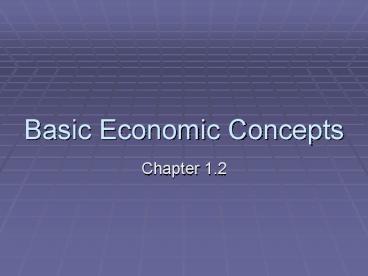Basic Economic Concepts PowerPoint PPT Presentation
1 / 11
Title: Basic Economic Concepts
1
Basic Economic Concepts
- Chapter 1.2
2
Goods, Services, Consumers
- Economic products are goods and services that are
useful, relatively scarce, and transferable. As
such, they command a price. - Goods satisfy an economic want (car, iPod, book).
- Consumer goods are intended for final use by
individuals. - Capital goods are used to produce other goods
(welding machine, espresso machine, bulldozer).
3
- Durable goods last 3 years with regular use
(car, espresso machine). - Nondurable goods last lt3 years with regular use
(paper, clothes, food). - Services Intangible products that are performed
for a consumer (concert, haircut, legal service,
surgery, boring economics lectures, etc. etc. ad
nauseam) - Consumer person who uses goods and services to
satisfy wants and needs.
4
Value, Utility, Wealth (Oh, My!)
- Value Worth that can be expressed in dollars and
cents. - Sometimes contradictions in need and value occur.
- Paradox of Value Water (cheap / necessary)
Diamonds (not cheap / not necessary). - Paradox is partially explained by scarcity.
Water is not scare, diamonds are.
5
Utility
- Value is also determined by utility, or the
capacity to be useful and provide satisfaction. - For something to have value, it must be scarce
and have utility ( diamonds definitely qualify).
6
Wealth
- Wealth is the accumulation of products that are
tangible, scare, useful, and transferable. - A countrys wealth is the total of all natural
resources, houses, factories, consumer goods,
etc. - In 1776, Adam Smiths Wealth of Nations dealt
with peoples skills and abilities as a major
source of wealth (pens assembly lines).
7
The Circular Flow of Economic Activity (p.15)
- A market is a location or other mechanism that
allows buyers and sellers to exchange products. - Factor markets are where any of the four factors
of production are purchased. - Product markets are where producers sell goods
and services to consumers (after payday see
above).
8
Productivity Economic Growth
- Economic growth is an increase in the total
output of goods and services in a nation over
time. - Productivity is the efficient use of scarce
resources. Productivity increases when more
outputs are created with the same amount of
inputs in the same amount of time.
9
Division of Labor Specialization
- Division of Labor occurs when a worker does a
limited number of specific tasks and becomes more
productive. - Specialization occurs when factors of production
(labor, capital goods, land) perform tasks very
efficiently. - Regional specialization Idaho potatoes, Nebraska
corn, Texas oil
10
Human Capital
- Investing in human capital includes the skills,
abilities, health, and motivation of people. - Government education, healthcare
- Business training, education
- Individuals education, motivation (see p.16)
11
Economic Interdependence
- Economic interdependence measures how much
producers and consumers rely on each other and
are effected by each other. - i.e. UPS strike workers lose pay, owners lose
money, business slows, people dont get HSN
orders on time switch to QVC.

